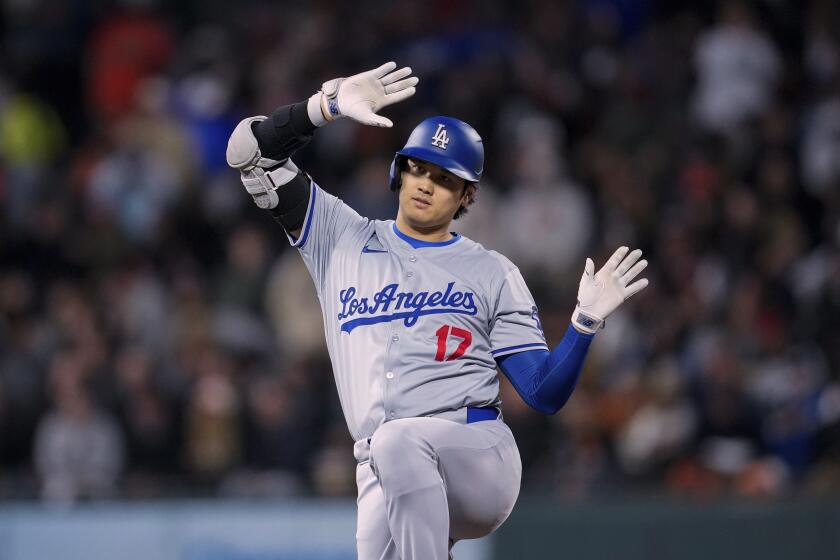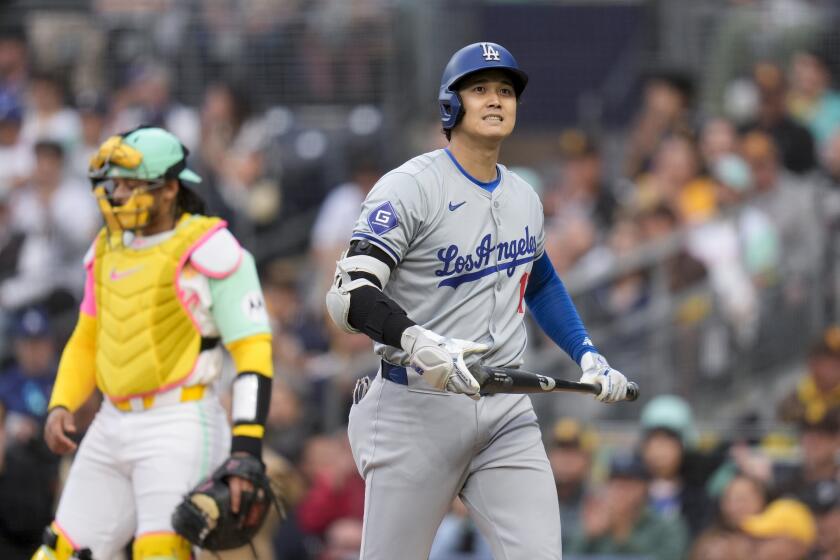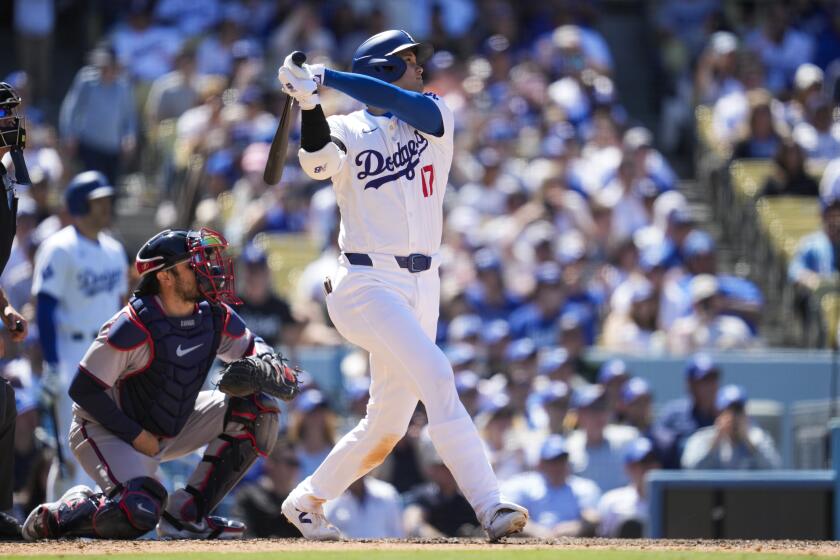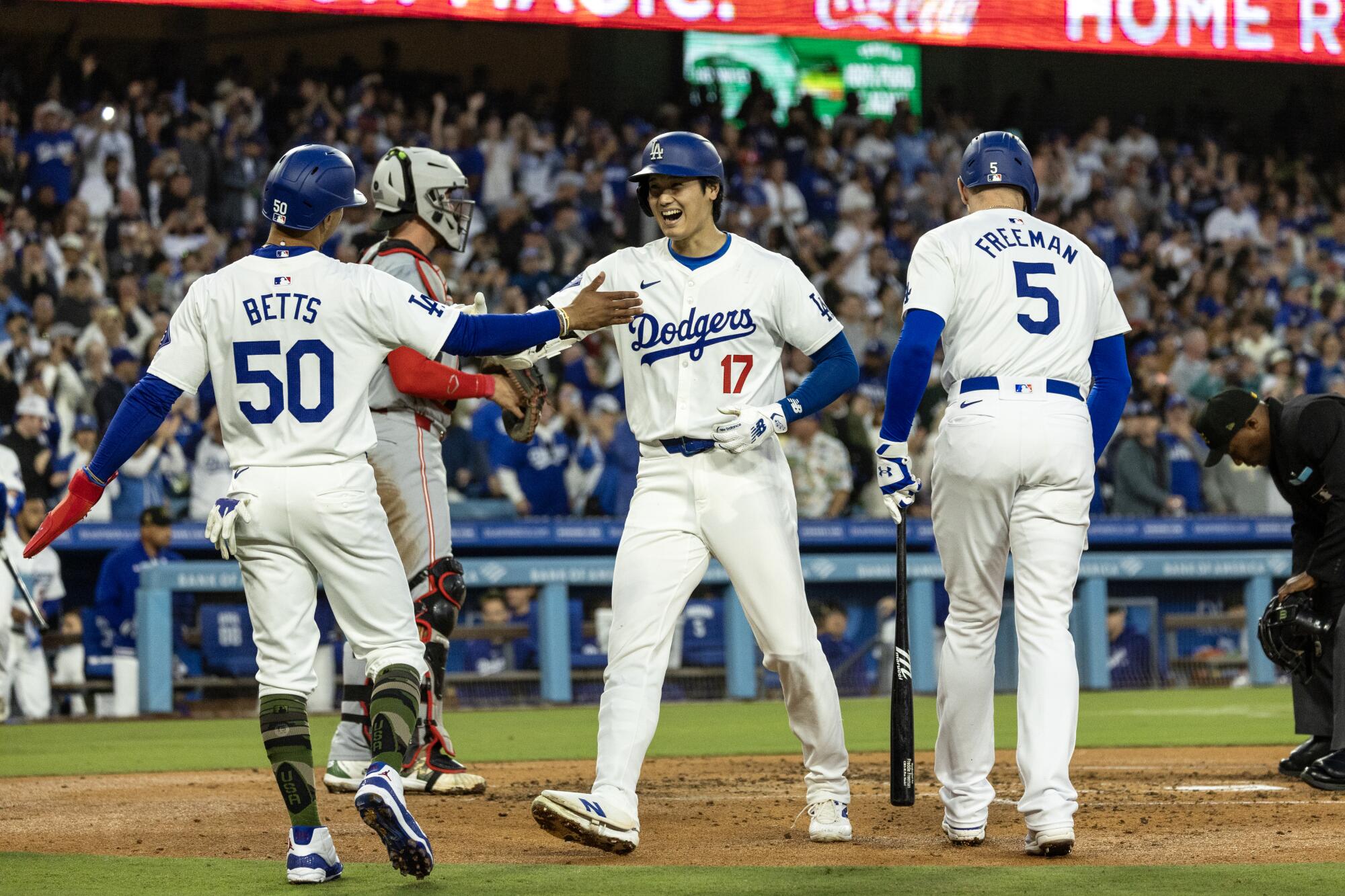
- Share via
On the first day of spring training, Dodgers manager Dave Roberts began drawing a lofty parallel.
Barry Bonds, Roberts said, “was the most talented player I’ve ever played with.”
Shohei Ohtani, he then predicted, “probably has a chance to be the most talented player to ever play the game of baseball.”
During a trip to San Francisco last week, Roberts witnessed the comparison in real life.
Back in the ballpark Bonds once called home, a stadium where Roberts has seen hundreds of games as a player and manager, the Dodgers’ skipper turned his gaze skyward after a thunderous Ohtani swing. His slugger had just clubbed a home run 446 feet with a blistering 113.4-mph exit velocity.
Roberts’ mind, however, could think only one thing.
“That’s Barry territory,” he said of a home run that cleared the towering right-center field bleachers at Oracle Park, landing just short of a splash down in McCovey Cove. “There aren’t too many guys that can do that.”
Then again, there aren’t too many players capable of having the kind of season Ohtani is having nearly 50 games in, a performance that is redefining the limits of his generational ceiling.
Entering Saturday, Ohtani was off to the best two-month start of his MLB career.
He was leading the majors in batting average (.358), slugging percentage (.676) and OPS (1.102), holding career highs in each statistic. He had 13 home runs, 11 stolen bases and 32 RBIs, putting him on pace for the first 45/35/100 season in MLB history.

Even without pitching — he continues to be a designated hitter as he recovers from elbow injury last year — Ohtani has been perhaps the most valuable player in the big leagues, tying Mookie Betts for the best mark in wins above replacement (3.1), according to Fangraphs.
In a season that could have been thrown off course by the pressure of his $700-million contract, the process of changing teams this offseason or the preoccupation with the gambling and theft scandal involving his former interpreter, Ippei Mizuhara, Ohtani is positioned to contend for his third MVP award and first World Series title, fulfilling every early season expectation the Dodgers could have dreamed.
“I do have moments where, [you realize] you have a chance to be around one of the best to ever play this game,” Roberts said last week. “He’s quite the talent.”
One who, even after all the offseason anticipation, amazes his new team a little more every day.
Betts’ adjustment was as subtle as it was telling; a sign of admiration for his power-hitting teammate, but an act of self-preservation on the bases as well.
Every time Betts is standing on first with Ohtani at the plate, the leadoff man will slightly alter his secondary lead. After a few routine shuffles toward second base, he’ll take a few hops back as the pitch is thrown.
Betts knows how hard Ohtani hits the ball. He wants to give himself a split-second of extra reaction time, just in case it comes screaming his way.
Shohei Ohtani hits a mammoth home run and the Dodgers have little trouble with the Giants in blowout victory.
“If that hits me, I’m out,” Betts said, only half-joking. “I weigh 175 pounds. I can’t take a 120- mph line drive.”
Ohtani hasn’t eclipsed 120 mph of exit velocity this year, but he has come close. Many times.
In what is perhaps Ohtani’s most defining trait as a hitter, the big-swinging slugger hits the ball harder than almost any other player in the majors — the violent, explosive and captivating end result of a physical and mental masterpiece he manages to keep perfectly in sync.
Ohtani has hit almost 62% of his batted balls this season harder than 95 mph, according to Baseball Savant (which defines a “hard hit” as being 95 mph or above), the best mark in MLB. He has eclipsed 105 mph 47 times, five more than any other hitter. His hardest-hit ball, a career-best 119.2 mph ground-ball single against the Toronto Blue Jays last month, has been topped this season only by Juan Soto and Giancarlo Stanton.
“He’s a freak of nature,” Roberts said. “He really is.”
The reason why Ohtani hits the ball so hard is where the true magic lies.
Conventional wisdom says that exit velocity should be primarily the product of bat speed. The harder the swing, after all, the firmer the contact. And the higher the exit velocity, years of pitch-tracking data have revealed, the better the results.
Except, bat speed doesn’t tell the whole story. Stanton, for example, has an MLB-best average speed of 80.5 mph (three mph higher than any other registered hitter, according to Baseball Savant) yet is hitting only .243. Of those ranking in the top 10 in bat speed, only one, Aaron Judge, also has a top-10 OPS, the statistic that most closely reflects a player’s overall production.
Ohtani’s average bat speed of 75.4 mph ranks 19th, hardly an outlier among the sport’s other big hitters.
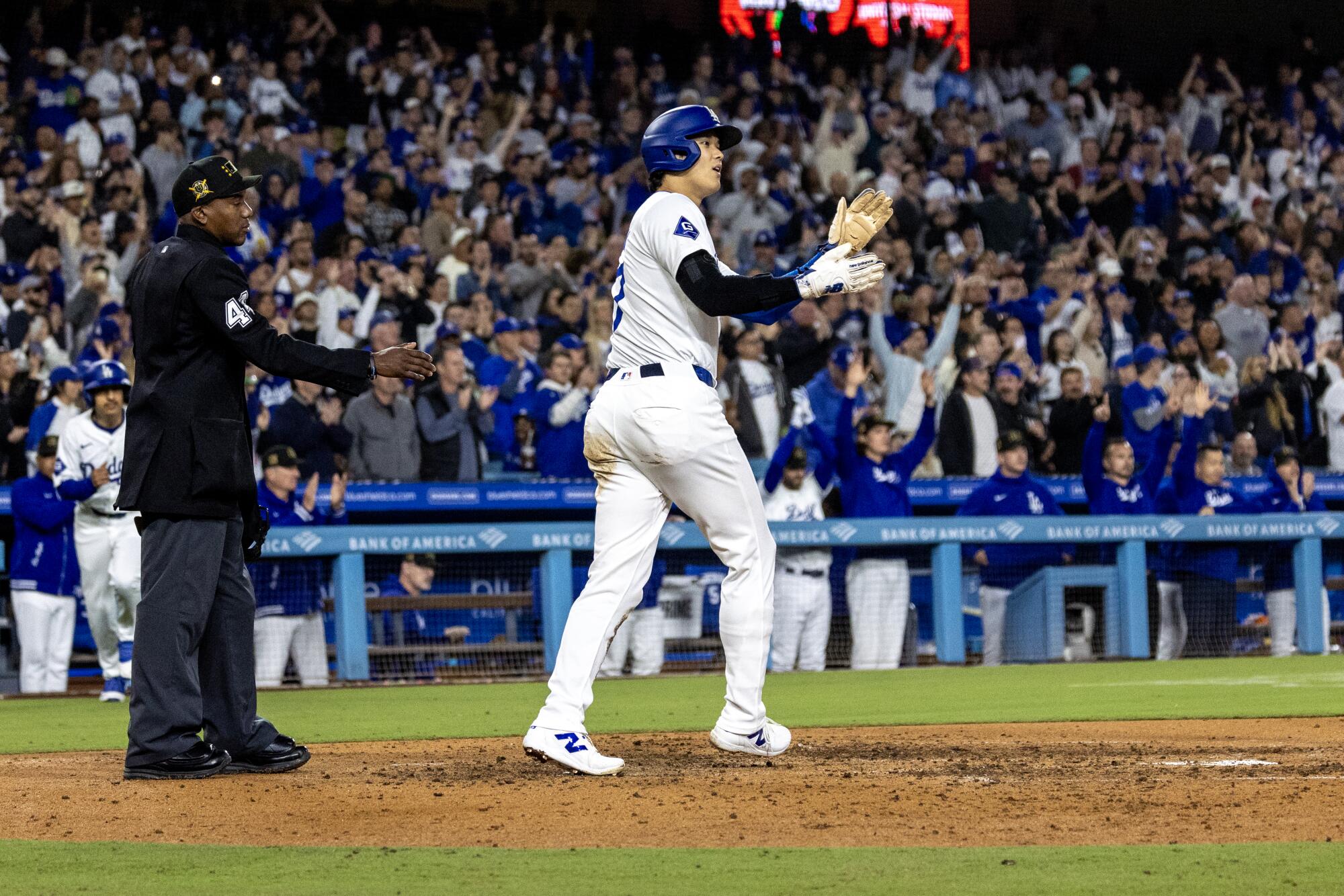
What sets him apart is the twitchy coordination and physical connectivity he couples with that strength and speed, a total package that, combined with his lanky 6-foot-4 frame, is difficult for even those who watch him every day to explain.
“I honestly don’t know,” Freddie Freeman said when asked about Ohtani’s ability to consistently clobber the ball. “He’s just that gifted.”
“When you’ve got the best athlete in baseball, and put that with some long levers,” hitting coach Aaron Bates added, “this is what you’re gonna see.”
Ohtani’s mechanics are efficient, repeatable and adaptive. It’s why he has rarely slumped this season, having gone hitless in consecutive games only once. It’s also why he’s able to hit an array of pitches, batting .333 or better against fastballs, breaking balls and offspeed offerings. No other qualified MLB hitter is doing the same.
“The bat to ball is an elite tool,” Bates said. “The hand-eye coordination, the ability to square up the baseball, that’s innate.”
So too is the execution of Ohtani’s approach. Though he’s an aggressive hitter, he still only chases pitches and whiffs on swings at league-average rates. He has cut down considerably on strikeouts to this point of the year, with a 19.5% K-rate that would easily set a career low. Even his one area of weakness during the opening month, batting with runners in scoring position, has improved in recent weeks, with Ohtani batting .417 in such situations in May.
This is what makes Ohtani a unicorn — even when he isn’t pitching.
He can swing hard but also accurately. He can catch up to velocity, or stay back on spin. He can clobber towering pull-side home runs, or slice a line drive in the gap the other way, such as the double he hit in his very next at-bat after the Bonds-like blast in San Francisco on Tuesday.
And, most of all, he can do it on an almost daily basis, maximizing his mesmerizing physical gifts with a singular mental drive.
“He’s doing everything,” Roberts reiterated. “He’s in rare air.”
During his time in MLB, Ohtani has been notorious for keeping a meticulous sleep schedule.
Which is why, when he talked recently about losing sleep at the start of the season, it sounded like much more than some flippant comment.
“There was a lot at the beginning [of the season going on],” Ohtani said in Japanese last week. “There were days I wasn’t sleeping enough.”
That might have been the case in normal circumstances this season, as Ohtani transitioned from an Angels mainstay to a face of the Dodgers’ high-profile franchise.
The distraction caused by Mizuhara’s alleged theft of $17 million from Ohtani’s bank account to pay for illegal gambling debts, however, made a start this prolific more improbable for the two-time MVP.
“There were many things that developed and I learned,” said Ohtani, whose claims of having no knowledge of, or involvement in, Mizuhara’s gambling activities was confirmed by a federal investigation.
Only “when things got resolved to a certain point,” Ohtani added, did he finally begin sleeping normally again. MLB’s investigation into the situation is still open, but every indication is that Ohtani was the victim of theft by Mizuhara, who is expected to plead guilty to multiple criminal charges.
Dodgers star Shohei Ohtani thought he might be able to play Sunday, but manager Dave Roberts made clear the division of labor that is needed.
Ohtani’s sleep hasn’t been the only thing to improve since Mizuhara was fired during the team’s season-opening trip to South Korea in March.
The 29-year-old has been seen as more open around his new clubhouse, engaging more in everything from direct conversation with coaches to the team’s roster-wide group text.
Last month, Roberts gave Ohtani some advice about his approach with runners in scoring position, the manager seeking him out “just like any other player,” he said.
Behind the scenes, Ohtani has been described as a lighthearted presence, willing to mess around with a cricket bat during a rain delay in Minnesota, and jokingly buy Roberts a toy car after breaking his record of most home runs by a Japanese-born Dodgers player a few weeks ago.
“It’s been more comfortable,” Ohtani said. “I’m getting good sleep and playing while treating every day with importance.”
Ohtani’s competitive edge has become apparent to the Dodgers.
Such as how strictly he follows his daily pregame routine, from his regimented cage work to his slowly intensifying throwing program. Or how hard he runs the bases, both in an effort to swipe bags (his 11 steals are tied for eighth most in the majors) and pick up an extra free 90 feet.
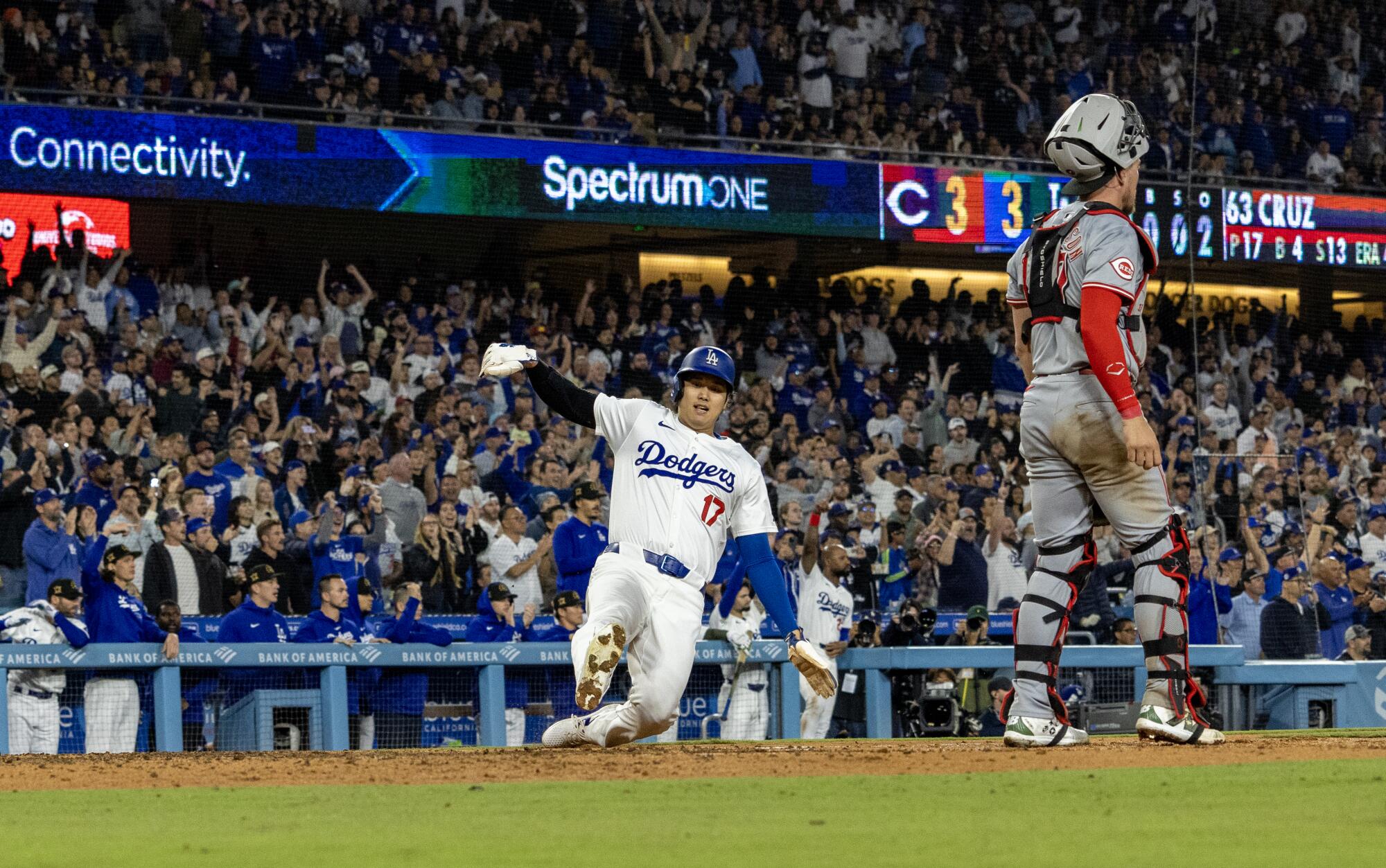
Even rare bouts of in-game frustration have been notable, such as during Wednesday’s game in San Francisco when Ohtani looked visibly frustrated with a couple of incorrect third-strike calls.
To Roberts, it’s all an indication of one thing — a dynamic not even the Mizuhara scandal could impede.
“He has craved and desired so long to play for a winner, play for a team that’s trying to play for a championship,” Roberts said last week. “And not to take anything away from the Angels, but I think what we’ve done, he’s seen that, and I think that’s raising his level of play.”
Ohtani hasn’t said so explicitly, remaining ever-respectful of the team that nurtured his two-way MLB dreams despite not making the playoffs once in his six seasons in Anaheim.
Yet, when asked about his blistering early season pace last week, he immediately credited the star-studded lineup he finds himself anchoring.
“I think my form is on the good side, but I don’t know if this is the best I’ve been in the last six years, seven years,” he said. “I think we’re having a lot of good at-bats as a lineup. As a member of that lineup, I think I’m having a great number of good at-bats.”
Chalk it up as the last trait to strike the Dodgers this year, with Ohtani’s quiet modesty belying his barrage to begin the season.
The Dodgers’ weekend sweep of the Braves was a fair predictor of an entirely different sort of October, one with slugging star Shohei Ohtani.
For now, his focus remains fixed on the mechanics of his swing, the recovery of his arm and the blocking out of any fallout from Mizuhara’s legal proceedings.
Career-best numbers, record-setting paces and Bondsian comparisons are for everyone else to contemplate.
“He just wants to be coached,” Roberts said. “He wants to be even better than he already is.”
More to Read
Are you a true-blue fan?
Get our Dodgers Dugout newsletter for insights, news and much more.
You may occasionally receive promotional content from the Los Angeles Times.

